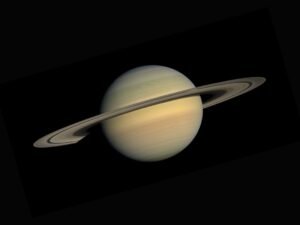Europa, one of Jupiter’s 79 known moons, has long been a subject of fascination for astronomers and space enthusiasts alike. Discovered by Galileo Galilei in 1610, Europa is the sixth-largest moon in the solar system and is slightly smaller than Earth’s moon. What sets Europa apart from other celestial bodies is its icy surface, which has led scientists to believe that there may be a vast ocean beneath it. This has sparked intense interest in the potential for extraterrestrial life on Europa, making it a prime target for future exploration missions. With its unique geology and potential for hosting life, Europa has become a focal point for scientific research and exploration in the quest to understand the mysteries of our solar system.
Europa’s surface is covered in a layer of ice, which is thought to be several miles thick. This icy shell is crisscrossed by a network of cracks and ridges, giving the moon a distinct and intriguing appearance. The most prominent feature on Europa is a series of long, linear cracks known as “lineae,” which are thought to be caused by the tidal forces exerted by Jupiter. These forces cause the ice to flex and crack, creating the intricate patterns that we see on the surface. In addition to the lineae, Europa also has a number of impact craters, although they are relatively few in number compared to other moons in the solar system. This suggests that the surface is relatively young and geologically active, with ongoing processes that continually reshape the landscape. The unique geology of Europa has captured the imagination of scientists and space enthusiasts alike, leading to numerous theories and hypotheses about what lies beneath the icy exterior.
Key Takeaways
- Europa is one of Jupiter’s moons and is considered a prime candidate for finding extraterrestrial life due to its subsurface ocean.
- The surface of Europa is covered in a layer of ice, but underneath lies a complex network of cracks, ridges, and chaotic terrain.
- The potential for life on Europa is supported by the presence of a subsurface ocean, which could provide the necessary conditions for microbial life to thrive.
- Several exploration missions have been proposed to study Europa, including the Europa Clipper mission by NASA, which aims to conduct detailed reconnaissance of the moon.
- Recent discoveries and theories suggest that Europa’s subsurface ocean may interact with the moon’s rocky mantle, potentially creating habitable environments for life.
Geology and Surface Features
Europa’s surface features are unlike anything else in the solar system, making it a fascinating subject for scientific study. The most striking aspect of Europa’s geology is its network of lineae, which are long, linear cracks that crisscross the moon’s surface. These features are thought to be caused by the tidal forces exerted by Jupiter, which cause the ice to flex and crack as it is pulled and pushed by the planet’s gravity. The presence of these lineae suggests that Europa’s icy shell is constantly being reshaped by these forces, leading to a dynamic and ever-changing landscape. In addition to the lineae, Europa also has a number of impact craters, although they are relatively few in number compared to other moons in the solar system. This suggests that the surface is relatively young and geologically active, with ongoing processes that continually reshape the landscape.
Another intriguing feature of Europa’s surface is its smooth plains, which are thought to be areas where the icy crust has been disrupted and refrozen. These regions are relatively flat and lack the rugged topography seen in other parts of the moon, leading scientists to believe that they may be areas where liquid water has welled up from beneath the surface. This has led to speculation that Europa may have a subsurface ocean, which could potentially harbor life. The combination of these unique surface features has made Europa a prime target for future exploration missions, as scientists seek to unlock the secrets of this enigmatic moon.
Potential for Life
One of the most compelling reasons for studying Europa is its potential for hosting extraterrestrial life. The presence of a subsurface ocean beneath its icy shell has led scientists to speculate that Europa may be one of the most promising places in the solar system to search for life beyond Earth. The conditions within this ocean are thought to be similar to those found in Earth’s oceans, with the potential for hydrothermal vents and other sources of energy that could support microbial life. In addition, the constant reshaping of Europa’s surface by tidal forces may provide a means for nutrients and organic material to be cycled between the surface and the subsurface ocean, creating a potentially habitable environment.
The potential for life on Europa has sparked intense interest in future exploration missions to the moon, with several proposed missions aiming to study its subsurface ocean and search for signs of biological activity. If life were to be discovered on Europa, it would have profound implications for our understanding of the universe and our place within it. It would also raise questions about the prevalence of life beyond Earth and what conditions are necessary for life to arise and thrive. While there is still much to learn about Europa and its potential for hosting life, it remains one of the most tantalizing targets for future exploration within our own solar system.
Exploration Missions
| Mission Name | Destination | Duration | Objectives |
|---|---|---|---|
| Apollo 11 | Moon | 8 days | First crewed mission to land on the Moon |
| Mars Rover Perseverance | Mars | Ongoing | Search for signs of ancient microbial life and collect rock and regolith samples |
| Voyager 1 | Interstellar space | Ongoing | Explore outer planets and enter interstellar space |
Several missions have been proposed to explore Europa and unlock its mysteries. One such mission is NASA’s Europa Clipper, which is set to launch in the 2020s. The Europa Clipper will conduct detailed reconnaissance of Europa’s surface and subsurface, aiming to understand the moon’s ice shell, subsurface ocean, chemistry, and geology. The spacecraft will carry a suite of scientific instruments designed to study Europa from orbit, including cameras, spectrometers, and radar instruments. These instruments will enable scientists to map the moon’s surface in unprecedented detail and search for signs of a subsurface ocean.
Another proposed mission is the European Space Agency’s Jupiter Icy Moons Explorer (JUICE), which is set to launch in 2022. JUICE will conduct detailed studies of Jupiter’s moons, including Europa, Ganymede, and Callisto, with a focus on understanding their potential for hosting life. The spacecraft will carry a suite of scientific instruments designed to study the moons’ surfaces, subsurface oceans, and magnetospheres, providing valuable insights into their geology and potential habitability.
These missions represent just a few of the many proposed missions aimed at exploring Europa and unlocking its mysteries. With each new mission, scientists hope to gain a better understanding of this enigmatic moon and its potential for hosting life beyond Earth.
Theories and Discoveries
The unique geology and potential for hosting life on Europa have led to numerous theories and discoveries that have captured the imagination of scientists and space enthusiasts alike. One of the most significant discoveries came from NASA’s Galileo spacecraft, which conducted multiple flybys of Europa in the 1990s. These flybys revealed evidence of a subsurface ocean beneath Europa’s icy shell, providing strong support for the idea that liquid water may exist on the moon.
In addition to this discovery, scientists have proposed several theories about how Europa’s subsurface ocean may interact with its surface. One theory suggests that water from the subsurface ocean may periodically erupt onto the surface through cracks in the ice, creating smooth plains and other distinctive features. Another theory proposes that hydrothermal vents may exist on the seafloor, providing a potential source of energy that could support microbial life.
These theories and discoveries have sparked intense interest in future exploration missions to Europa, as scientists seek to test these hypotheses and unlock the secrets of this enigmatic moon.
Future Exploration and Research

As interest in Europa continues to grow, future exploration missions are being planned to unlock its mysteries. NASA’s Europa Clipper mission is set to launch in the 2020s and will conduct detailed reconnaissance of Europa’s surface and subsurface. The spacecraft will carry a suite of scientific instruments designed to study Europa from orbit, providing valuable insights into its geology, chemistry, and potential habitability.
In addition to these planned missions, scientists are also considering future lander missions that could directly study Europa’s surface and subsurface. These missions would aim to search for signs of biological activity and potentially even collect samples from the moon’s subsurface ocean.
As technology continues to advance, our ability to explore Europa will only continue to improve, providing new opportunities to unlock its mysteries and potentially discover signs of extraterrestrial life.
Conclusion and Implications
Europa’s unique geology and potential for hosting life make it one of the most intriguing targets for future exploration within our own solar system. The presence of a subsurface ocean beneath its icy shell has led scientists to speculate that Europa may be one of the most promising places in the solar system to search for life beyond Earth.
The implications of discovering life on Europa would be profound, raising questions about the prevalence of life beyond Earth and what conditions are necessary for life to arise and thrive. It would also have profound implications for our understanding of the universe and our place within it.
As we continue to explore Europa and unlock its mysteries, we may be on the brink of one of the most significant discoveries in human history – the discovery of extraterrestrial life within our own solar system.
Discovering the potential for life on Europa, one of Jupiter’s moons, has sparked excitement and curiosity among scientists and space enthusiasts alike. As researchers continue to explore the possibility of finding extraterrestrial life in our own solar system, it’s important to stay informed about the latest developments in space exploration. In a recent article on Just Tidings, “Alaskapox: A Newly Discovered Virus Claims Its First Victim in Alaska,” sheds light on a newly discovered virus that has raised concerns in the scientific community. This serves as a reminder of the ongoing importance of scientific research and discovery, whether it’s here on Earth or beyond. (source)




















+ There are no comments
Add yours